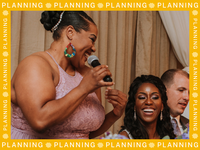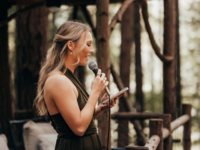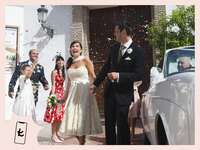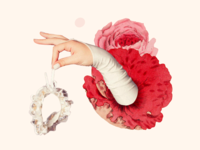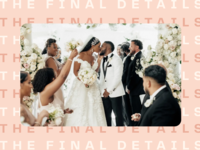The Most Common Malay Wedding Traditions That are Rich in History


Invited to a Malay wedding for the very first time? With so many rituals and time-honored wedding traditions, you're about to get an extra dose of culture. "Malay weddings are known for lavish celebrations and feasts," explains Pooja Singh Chauhan of Blissful Plans, an international wedding planner who often works with clients in Malaysia. "The celebrations go on for many days with events reflecting the traditional Malay customs." That said, there's more to a Malay wedding than meets the eye. Since the Malaysian Chinese community is the second largest group of "overseas Chinese" in the world, it's possible that your nuptials might have a sprinkling of elements from a traditional Chinese wedding. And, thanks to the rise of Malaysians who identify as Islamic, you might notice some hints of Muslim traditions throughout the celebration.
With so many global sources of inspiration, there isn't one way to have a traditional Malaysian wedding. (Nowadays, couples can pick and choose wedding customs that best suit their needs.) To help you get a crash course in Malay culture—so you can fully enjoy everything the big day—read on to learn more about key features of a traditional Malay wedding.
A Brief History in Malay Weddings
Malaysia is considered a melting pot of cultures—and for good reason. Historically, Chinese people were present in Malaysia and to this day, 22.8 percent of the country's citizens are classified as ethnic Chinese. (Meanwhile, the country's largest ethnic group is Bumiputera, a term used to describe Malay and various indigenous in Southeast Asia. Religious diversity is another key part of Malay culture. While Hindu used to be the country's primary religion, the Muslim community made its way to Malaysia around the 10th century. Nowadays, reports suggest that over 60 percent of the Malay population identify as Islamic. The result? Wedding traditions that are just as rich and layered as Malaysian history.
Malay Prewedding Traditions
Couple meets, falls in love, and gets engaged. Right? Well, in Malay culture, it's a little more complicated than that. Read on to learn more about the Malaysian road to an engagement.
Meet for a Merisik
In Malay culture, the very first step to marriage is a meeting called a merisik. When a man is attracted to a woman—and is keen on marrying her—he'll ask an older member of his family to stop by the potential bride's house. During the meeting the man's family member will learn more about the bride-to-be and ask her parents if she's single. If she is, the man's family will ask for her hand in marriage. Since most modern Malay couples have known each other for years, a merisik might feel like a slightly outdated tradition.
Bertunang Betrothal
Once the families have agreed on the engagement, it's time to pick a date to pop the question. During the bertunang, or engagement ceremony, the groom will give the bride an engagement ring and the couple will exchange gifts. Typically an engagement period lasts between six months and three years, and couple continue to exchange gifts in odd numbers as even digits are considered unlucky.
Honor The Milestone With Henna
Shortly before the wedding day, there will be an adat berinai, which is when henna will be applied to the bride and groom's hands and fingers. Henna is a very common Muslim wedding tradition and is typically thought of as a way to ward off evil spirits.
Malay Wedding Attire
Though Singh Chauhan says Malay weddings are filled with opulence, the couple takes a pared-back approach for their outfits. The traditional attire for the groom is the "baju melayu," or a long-sleeved shirt. Typically made from silk or cotton, the baju melayu is typically paired with loose pants and a sarong-like wrap called a sampin. For the perfect finishing touch, the groom can add a small cap called a songkok.
Meanwhile, the bride typically sports a loose-fitting dress called a "baju kurung' or a "baju kebaya," [which is a] long-sleeve blouse available in an array of materials like cotton, gauze, lace and so on.



The bride also typically wears traditional Malay jewelry, such as gold earrings, necklaces, and bracelets. She may also wear a traditional headdress known as the "tudung," which is a scarf that is worn over the hair and is pinned to the head.
As for the guests? Depending on the season, Malay weddings can get a little hot; however, it's important to dress conservatively as a sign of respect for the bride, groom, and their families. Fortunately, Malays don't believe in any unlucky colors so they are free to wear whichever shade suits their style.
Malay Wedding Ceremony Traditions
Now that the wedding date is finally here, it's time to kick off the festivities with a solemnization ceremony known as "akad nikah." While this part of the wedding day almost always takes place at the bride's home or a mosque, who conducts the services is up for debate. While some ceremonies are headed up by the "wali," the father or older relative in the bride's family, others are performed by a Muslim religious official called a "kadi."
During the ceremony, the bride and groom sit together in front of the wali or kadi, who will ask for their consent to the marriage and recite prayers from the Quran. From there, the couple signs the marriage contract, which is sealed with a typically monetary gift from the groom to the bride called mas kahwin. In Malay culture, mas kahwin signifies the groom's responsibility to honor and protect his wife.
Malay Wedding Reception Traditions
Once the marriage contract as been signed and the mas kahwin is exchanged, Singh Chauhan says it's time to celebrate the newlyweds with a "majlis perkahwinan." Unlike the akad nikah, which is typically reserved for close family members and friends, this larger wedding reception is open to everyone from extended family to acquaintances. (More times than not, this portion of the wedding celebration is held in a While the specifics will vary by the couple, this portion of the wedding experience doesn't have a fixed schedule.
Bersanding Ceremony
While wedding guests can come and go as they please, "bersanding" is a non-negotiable. As a tradition that symbolizes the formal acceptance of the newlyweds by their families and friends, bersanding the bride and groom's opportunity to be treated like royalty. The couple sits right next to each other on an altar-like setup called a pelamin and have their guests stop by and sprinkle flower petals and yellow rice grains over the newlyweds.
Though one bersanding ceremony is usually sufficient for Malay couples, some newlyweds might choose to have an additional session.
Bunga Telur Treat
Goodie bags, anyone? Sometimes, guests are given bunga telur as a way to say "thank you" for adding the wedding services. As a hard-boiled egg placed on a bed of rice, bunga telur
Malay Traditional Wedding Food, Drinks and Dessert
Hungry? Malay wedding receptions will typically feature a large feast called a "nasi minyak." "Food is very important and symbolic in Malay wedding traditions," Singh Chauhan shares. "Yellow rice is an integral part and all the traditional items served in wedding food have a meaning attached like family bonding, love and fertility."
Malay Postwedding Traditions
According to Singh Chauhan, the akad nikah and majlis perkahwinan are the two biggest components of a Malaysian wedding. However, she says there are "many small events and rituals [that] are hosted by the families" so you may notice some small nuances depending on location, religion, and culture. For example, bersanding ceremonies in Singapore are often followed by a percussion march known as kompang. In this tradition, the groom walks to the bride's house to be reunited and enjoy their first meal as husband and wife. Of course, he's not alone; his friends are walking beside him holding colorful palm blossoms.



